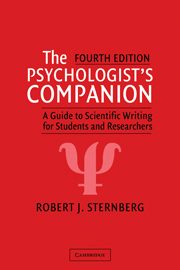Book contents
- Frontmatter
- Contents
- Acknowledgments
- Introduction
- 1 Eight Common Misconceptions about Psychology Papers
- 2 Steps in Writing the Library Research Paper
- 3 Steps in Writing the Experimental Research Paper
- 4 Rules for Writing the Psychology Paper
- 5 Using the Internet to Aid the Research Process
- 6 Commonly Misused Words
- 7 American Psychological Association Guidelines for Psychology Papers
- 8 Guidelines for Data Presentation
- 9 References for the Psychology Paper
- 10 Standards for Evaluating the Psychology Paper
- 11 Submitting a Paper to a Journal
- 12 How to Win Acceptances from Psychology Journals: Twenty-Nine Tips for Better Writing
- 13 Writing a Grant or Contract Proposal
- 14 How to Find a Book Publisher
- 15 Writing a Lecture
- 16 Article Writing 101
- References
- Appendix A Sample Psychology Paper
- Appendix B Writing for British and European Journals
- Index
7 - American Psychological Association Guidelines for Psychology Papers
Published online by Cambridge University Press: 05 June 2012
- Frontmatter
- Contents
- Acknowledgments
- Introduction
- 1 Eight Common Misconceptions about Psychology Papers
- 2 Steps in Writing the Library Research Paper
- 3 Steps in Writing the Experimental Research Paper
- 4 Rules for Writing the Psychology Paper
- 5 Using the Internet to Aid the Research Process
- 6 Commonly Misused Words
- 7 American Psychological Association Guidelines for Psychology Papers
- 8 Guidelines for Data Presentation
- 9 References for the Psychology Paper
- 10 Standards for Evaluating the Psychology Paper
- 11 Submitting a Paper to a Journal
- 12 How to Win Acceptances from Psychology Journals: Twenty-Nine Tips for Better Writing
- 13 Writing a Grant or Contract Proposal
- 14 How to Find a Book Publisher
- 15 Writing a Lecture
- 16 Article Writing 101
- References
- Appendix A Sample Psychology Paper
- Appendix B Writing for British and European Journals
- Index
Summary
This chapter summarizes the guidelines for preparing a psychology paper presented in the Publication Manual of the American Psychological Association, Fifth Edition (2001). This manual should be consulted for a complete list of guidelines. If you intend to submit a paper for publication, then you cannot afford to be without this manual. It can be obtained from Publication Sales, American Psychological Association, 750 First Street, NE, Washington, DC, 20002-4242.
Journals of the British Psychological Society (BPS), and many other non-APA journals, will accept papers prepared in accordance with APA guidelines, even though there are minor differences in style. Some examples of the main differences between BPS and APA styles are given in Appendix B.
All examples used to illustrate principles in this chapter are fictitious.
WORD-PROCESSING THE PAPER
Rules of Format
Paper. Print your paper on one side only of heavy, white, inch paper. Do not use onionskin, which lacks durability, or erasable paper, which smudges easily. Do not paste or glue together pieces of pages. Reprint those pages that otherwise would require pasting.
Margins. Set your margins to leave 1 inch at the top, bottom, and both sides of each page. Allow for a inch line. This length is obtained by allowing 65 characters of pica (large) typeface, or 78 characters of elite (small) typeface. Do not right-justify lines (i.e., use a uniform printed right margin, as in printed pages) or use proportional spacing (i.e., different spacings between words on different lines).
- Type
- Chapter
- Information
- The Psychologist's CompanionA Guide to Scientific Writing for Students and Researchers, pp. 119 - 141Publisher: Cambridge University PressPrint publication year: 2003



